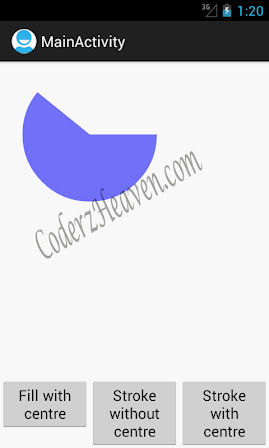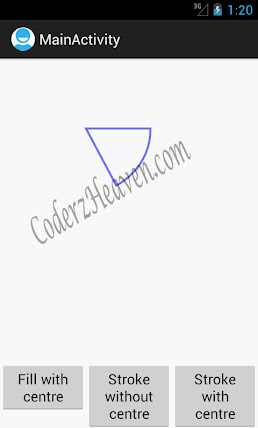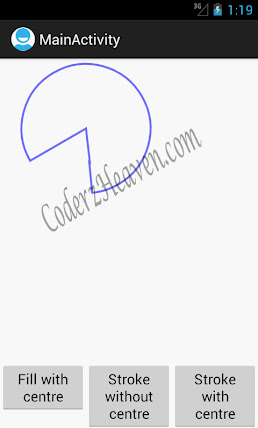This is a simple example showing how to draw Arcs in android, You can use this to create piecharts or someother similar thing you want.




Here we have 3 classes.
1. GraphicsActivity.java
2. MainActivity.java
3. PictureLayout.java
GraphicsActivity.java
package com.coderzheaven.arcdrawing;import android.app.Activity;import android.os.Bundle;import android.view.View;import android.view.ViewGroup;class GraphicsActivity extends Activity { // set to true to test Picture private static final boolean TEST_PICTURE = false; @Override protected void onCreate(Bundle savedInstanceState) { super.onCreate(savedInstanceState); } @Override public void setContentView(View view) { if (TEST_PICTURE) { ViewGroup vg = new PictureLayout(this); vg.addView(view); view = vg; } super.setContentView(view); }} |
PictureLayout.java
package com.coderzheaven.arcdrawing;import android.content.Context;import android.graphics.Canvas;import android.graphics.Picture;import android.graphics.Rect;import android.graphics.drawable.Drawable;import android.util.AttributeSet;import android.view.View;import android.view.ViewGroup;import android.view.ViewParent;public class PictureLayout extends ViewGroup { private final Picture mPicture = new Picture(); public PictureLayout(Context context) { super(context); } public PictureLayout(Context context, AttributeSet attrs) { super(context, attrs); } @Override public void addView(View child) { if (getChildCount() > 1) { throw new IllegalStateException("PictureLayout can host only one direct child"); } super.addView(child); } @Override public void addView(View child, int index) { if (getChildCount() > 1) { throw new IllegalStateException("PictureLayout can host only one direct child"); } super.addView(child, index); } @Override public void addView(View child, LayoutParams params) { if (getChildCount() > 1) { throw new IllegalStateException("PictureLayout can host only one direct child"); } super.addView(child, params); } @Override public void addView(View child, int index, LayoutParams params) { if (getChildCount() > 1) { throw new IllegalStateException("PictureLayout can host only one direct child"); } super.addView(child, index, params); } @Override protected LayoutParams generateDefaultLayoutParams() { return new LayoutParams(LayoutParams.MATCH_PARENT, LayoutParams.MATCH_PARENT); } @Override protected void onMeasure(int widthMeasureSpec, int heightMeasureSpec) { final int count = getChildCount(); int maxHeight = 0; int maxWidth = 0; for (int i = 0; i < count; i++) { final View child = getChildAt(i); if (child.getVisibility() != GONE) { measureChild(child, widthMeasureSpec, heightMeasureSpec); } } maxWidth += getPaddingLeft() + getPaddingRight(); maxHeight += getPaddingTop() + getPaddingBottom(); Drawable drawable = getBackground(); if (drawable != null) { maxHeight = Math.max(maxHeight, drawable.getMinimumHeight()); maxWidth = Math.max(maxWidth, drawable.getMinimumWidth()); } setMeasuredDimension(resolveSize(maxWidth, widthMeasureSpec), resolveSize(maxHeight, heightMeasureSpec)); } private void drawPict(Canvas canvas, int x, int y, int w, int h, float sx, float sy) { canvas.save(); canvas.translate(x, y); canvas.clipRect(0, 0, w, h); canvas.scale(0.5f, 0.5f); canvas.scale(sx, sy, w, h); canvas.drawPicture(mPicture); canvas.restore(); } @Override protected void dispatchDraw(Canvas canvas) { super.dispatchDraw(mPicture.beginRecording(getWidth(), getHeight())); mPicture.endRecording(); int x = getWidth()/2; int y = getHeight()/2; if (false) { canvas.drawPicture(mPicture); } else { drawPict(canvas, 0, 0, x, y, 1, 1); drawPict(canvas, x, 0, x, y, -1, 1); drawPict(canvas, 0, y, x, y, 1, -1); drawPict(canvas, x, y, x, y, -1, -1); } } @Override public ViewParent invalidateChildInParent(int[] location, Rect dirty) { location[0] = getLeft(); location[1] = getTop(); dirty.set(0, 0, getWidth(), getHeight()); return getParent(); } @Override protected void onLayout(boolean changed, int l, int t, int r, int b) { final int count = super.getChildCount(); for (int i = 0; i < count; i++) { final View child = getChildAt(i); if (child.getVisibility() != GONE) { final int childLeft = getPaddingLeft(); final int childTop = getPaddingTop(); child.layout(childLeft, childTop, childLeft + child.getMeasuredWidth(), childTop + child.getMeasuredHeight()); } } }} |
MainActivity.java
package com.coderzheaven.arcdrawing;import android.content.Context;import android.graphics.Canvas;import android.graphics.Color;import android.graphics.Paint;import android.graphics.Paint.Style;import android.graphics.RectF;import android.os.Bundle;import android.view.View;import android.view.View.OnClickListener;import android.widget.Button;import android.widget.LinearLayout;public class MainActivity extends GraphicsActivity implements OnClickListener { @Override protected void onCreate(Bundle savedInstanceState) { super.onCreate(savedInstanceState); setContentView(R.layout.activity_main); Button b1 = (Button) findViewById(R.id.button1); Button b2 = (Button) findViewById(R.id.button2); Button b3 = (Button) findViewById(R.id.button3); b1.setOnClickListener(this); b2.setOnClickListener(this); b3.setOnClickListener(this); } @Override public void onClick(View v) { int id = v.getId(); Style sytle = null; boolean use_centre = false; final LinearLayout r1 = (LinearLayout) findViewById(R.id.l1); if (MainActivity.this.findViewById(1) != null) r1.removeView(MainActivity.this.findViewById(1)); switch (id) { case R.id.button1: use_centre = true; sytle = Paint.Style.FILL; break; case R.id.button2: use_centre = false; sytle = Paint.Style.STROKE; break; case R.id.button3: use_centre = true; sytle = Paint.Style.STROKE; break; default: break; } SampleView s = new SampleView(MainActivity.this); s.setId(1); s.startDraw(sytle, use_centre); r1.addView(s); } private static class SampleView extends View { private Paint mPaint; private Paint mFramePaint; private RectF mBigOval; private float mStart; private float mSweep; private boolean use_centre = false; private static final float SWEEP_INC = 0.5f; private static final float START_INC = 15; public SampleView(Context context) { super(context); mPaint = new Paint(); mPaint.setAntiAlias(true); mPaint.setColor(0x880000FF); mPaint.setStrokeWidth(4); mBigOval = new RectF(40, 10, 280, 250); mFramePaint = new Paint(); mFramePaint.setAntiAlias(true); mFramePaint.setStrokeWidth(4); } public void startDraw(Style style, boolean use_centre) { this.use_centre = use_centre; mPaint.setStyle(style); mFramePaint.setStyle(style); } private void drawArcs(Canvas canvas, RectF oval, boolean useCenter, Paint paint) { // canvas.drawRect(oval, mFramePaint); canvas.drawArc(oval, mStart, mSweep, useCenter, paint); } @Override protected void onDraw(Canvas canvas) { canvas.drawColor(Color.WHITE); drawArcs(canvas, mBigOval, use_centre, mPaint); mSweep += SWEEP_INC; if (mSweep > 360) { mSweep -= 360; mStart += START_INC; if (mStart >= 360) { mStart -= 360; } } invalidate(); } }} |
Download the complete source code from here.
Pingback: android - Come disegnare una linea curva in android?
Pingback: How to draw a curved line in android?